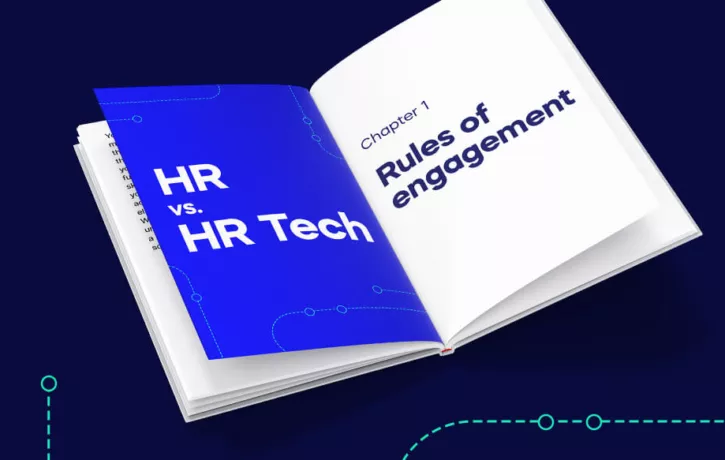The number of ways in which we can engage employees grows with each new digital medium. Each piece of software, each device—they are all meant to simplify our lives, but in reality, each one just creates another opportunity to say:
“Sorry, I didn’t see that message…Where did you send it? Oh, I never use that…”
Information is quickly lost among the fray, destined to drown in the sea of notifications that fills your employees’ multiple communication platforms.
To prevent employees from disengaging time and time again, I have built you a list of rules to follow when managing and enhancing employee engagement.
[If you find it relevant, feel free to share this article with your colleagues so you can all get on the same page.]
Rule #1: Invest in the right software for your company (UX matters)
More likely than not, your employees will be on their devices for the majority of the workday. With the average employee regularly using between 8-11 applications, there are a lot of opportunities to get stuck in extensive and repetitive workflows.
Applications with seamless user experiences keep employees engaged with their software for all the right reasons. Rather than losing the motivation to fill out their timesheets for the 100th time, you could offer them a quick and easy way, straight from their desktops.
Nothing will lower the engagement of an employee like empty clicks in a frustrating software they are forced to use by their HR department.
So, minimize the number of applications your employees will need to navigate and try to find apps that can be customized and personalized.
Rule #2: Have one source of truth that everyone will see
Does this situation sound familiar to you?
– – –
*Ding*
Message from company email address.
Subject line: Important, please read.
Open email
Hi Everyone,
We will be holding a company “All Hands” meeting this Thursday at 3:00 PM.
Looking forward to (virtually) seeing you all there!
Best,
– CompanyX Team
[One day later]
*Ding*
Message received on internal company communication platform.
Hi everybody!
We will be holding a company “All Hands” meeting this Thursday.
Looking forward to (virtually) seeing you all there!
Make sure to mark your calendars!
– CompanyX Team
[Two days later]
*Ding*
Text message received from manager in team group chat.
Hey everyone, please make sure to join the company meeting later today. It’s super important for us to be there.
– – –
Three separate messages, each with less information about the meeting.
If this is how your company notifies employees about important events, you are wasting the time of both the employees anyone who is writing and sending out these messages.
Instead, select a unified communications solution that can reach employees where they are and when it is relevant. On some systems, you can even ask them to confirm by marking a simple checkbox within the message you send out.
Spend less time trying to communicate and guessing if people have received your updates. Get the message across and move on to your next project while your analytics take note of compliance.
Rule #3: Think of your employees as your customers
If you want to engage and connect with your employees, you’re going to have to show them that you understand who they are and what they like.
In the same manner that marketing, sales, and product departments try to customize their content for different audiences, so should HR.
Consider the following when creating content for your employees:
- Employee ages
- Employee locations
- Employee roles
- Employee tenure at the company
- Goal of the content
- General interests of your employees
- The medium on which the content will be read
Keeping this information in mind while building your content will help to ensure it is interesting, relevant, and engaging.
Rule #4: Give everyone a voice
Employees who receive respect and attention will want to engage more often. By actively asking for feedback, you offer employees the opportunity to influence their work environment.
Maintain an open stream of communication. Whether it’s through surveys, an email request inbox, quarterly check-ins, or any other form of engagement, letting employees know their voices are heard does wonders for their self-esteem and overall satisfaction.
Connect with your employees and listen to their thoughts. Don’t be surprised if you see productivity begin to rise (and maybe even a few more reactions to company posts on social media).
Rule #5: Offer the same engagement at the company office and at the home office
No one likes to be left out. It’s as simple as that.
And because a certain global medical risk has made hybrid workforces the new normal, companies need to provide the same level of engagement off-site as they do on-site.
From an accessibility standpoint, use cloud solutions to your advantage and make sure every tool your employees need to perform can be accessed regardless of their location.
Having a fun party at the office with food and drinks?
Consider sending care packages directly to the homes of employees who can’t make it.
Whatever the type of engagement, do your absolute best to share the love. Your employees will thank you for it.
End of Chapter 1
The next chapter in the HR vs. HR Tech series will cover how to prove business value with your HR software. It is entitled, “Chapter 2 – Sleight-of-hand ROI”.
Subscribe to the WalkMe Blog so you don’t miss out!

